Legendary Intel Core i7-2600K: Sandy Bridge Testing in 2019 (Part 3)
Part 1 >> Part 2 >> Part 3
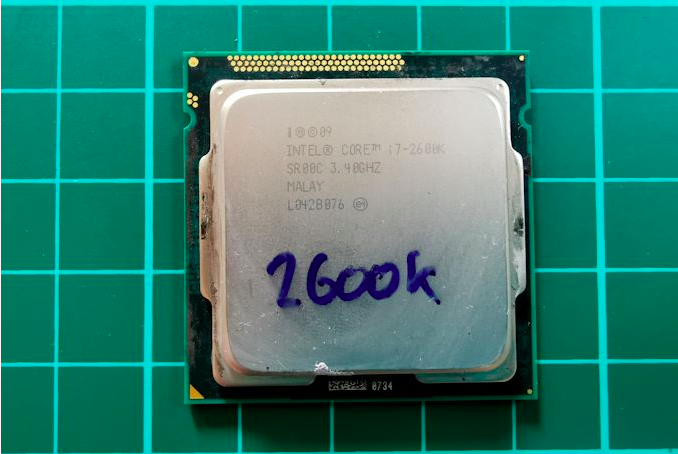
Despite the fact that World of Tanks is very different from most other frequently played massively multiplayer online games, it allows the player to find himself in the middle of the 20th century and control a number of armored combat vehicles. World of Tanks (WoT) is developed and published by Wargaming, which are based in Belarus, and the soundtrack for the game is mainly written by the Belarusian composer Sergei Khmelevsky. The game offers several entry points, including free-to-play, and also allows players to pay for additional features. One of the most interesting facts about this tank-based MMO is that it reached eSports status when it debuted at World Cyber Games back in 2012.

')
World of Tanks enCore is a demo application for a new and unreleased graphics engine created by the Wargaming development team. Over time, the new main engine will be implemented in the full game, updating the game visual effects in the most key elements, such as improved water, flora, shadows, lighting, as well as other objects. The World of Tanks enCore demo application not only reveals information about upcoming changes in the game engine, but also allows users to check the system performance to make sure that the home system processes the new engine normally.

Igp

Low

Medium

High

Igp

Low

Medium

High

As in many CPU tests, the 2600K overclocked is in the middle between the 2600K and 7700K stock, at least to 1080p Ultra. The 4K Ultra Overclocked 2600K and 7700K, in fact, have the same performance, but the base 2600K certainly has the worst result of the 95th percentile.
Upon arrival to the computer not so long ago, the graphics of Final Fantasy XV: Windows Edition was redone because it was transferred from the console, as a result of their successful partnership with NVIDIA, with almost no mention of the production and development of the original Final Fantasy XV.
In preparation for the launch, Square Enix decided to release a stand-alone benchmark, which they recently updated. The use of stand-alone benchmark Final Fantasy XV gives us a long-term and reliable point of reference. Although it should be noted that the intensive use of NVIDIA technology by the benchmark means that it has problems with “maximum” parameters - it renders elements off-screen. To get around this, we use a standard preset that does not have these problems.

Square Enix patched the benchmark with custom graphic settings, and made corrections to give a more accurate result in the profiling of game performance, and the graphic parameters in the game. For testing, we run a standard benchmark with FRAP overlay using a 6-minute test record.
Igp

Low

Medium

High

Igp

Low

Medium

High

As for Final Fantasy, all the chips worked basically the same, starting with 4K and higher (for some reason, the overclocked system test failed at 8K), but at 1080p the overclocked chip is still between the 2600K / 7700K stock.
Originally launched by Sid Meier and his team, the Civ series of turn-based strategies became a cult classic. Many apologies were made for the sleepless nights of the players, who could not make Gandhi go to war because of the overflow of whole numbers. In truth, I have never played the first version, but I played in every part from the second to the sixth, including the fourth, voiced by the late Leonard Nimy. This is a game that is easy to play, but hard to play well.

Civilization benchmarking has always been something like an oxymoron - for a turn-based strategy game the frame rate is not particularly important, and with the right mood, only 5 frames per second is enough for a good game. However, with Civilization 6, Firaxis has hit hardcore and raised the visualization bar, trying to get you involved in the game. As a result, Civilization may require from the player a new video card and processor, especially if you play with high details under DirectX 12.
Perhaps a more in-demand result will be visible during a late game, when, in older versions, Civilization could take 20 minutes to make the AI players move and transfer control to the person. The new version of Civilization has an integrated “AI Benchmark”, although at present it is not yet included in our portfolio of tests for technical reasons that we are trying to solve. Instead, we run a graphical test, which provides an example of average game settings in options.

Igp

Low

Medium

High

Igp

Low

Medium

High

Civilization is a game that does not depend on the frame rate by itself, and the inclusion of all settings helps a lot. However, even in 4K, there is a noticeable difference in runoff performance of 2600K and 7700K, which is halved when 2600K is overclocked.
The beloved child of DirectX12, Ashes of the Singularity (AoTS or simply Ashes) was the first name to actively explore as many DirectX12s features as possible. Stardock, the developer of the Nitrous engine that runs the game, made sure that the real-time strategy takes advantage of several cores and several video cards in the maximum possible set of configurations.

As real-time strategy is supposed to be, Ashes is a quick response both during wide open species and in mass battles. With DirectX12 at the helm, the ability to make more calls per second allows the engine to work with a significant depth of drawing units and effects. At the same time, some other RTSs had to rely on combined drawing, making the combined unit structures very rigid.
Stardock well understands the need for an internal benchmark test in the game, ensuring that this tool is available and operational from the day the game is released. This is especially important given the use of all the new features of the DX12, since it was important for the developer to understand how they affected the game. The in-game test performs a four-minute fixed battle scene with multiple shots and displays a huge amount of data for analysis.
For our test, we run Ashes Classic - an older version of the game, before updating Escalation. The old version is easier to automate, it does not use splash screen, but still has good visual accuracy for testing.
Igp

Low

Medium

High

Igp

Low

Medium

High

Ashes has a drop-down menu with settings for MSAA, Light Quality, Object Quality, Shading Samples, Shadow Quality, textures and individual settings for the landscape. There are several presets, from Very Low to Extreme. We run our tests on various settings and derive the average FPS and 95th percentile.
In Ashes, we see a difference in performance between chips up to 4K, but the overclocked 2600K and the stock 7700K work almost equally on 4K. Starting at 1440p and lower, the overclocked 2600K begins to lag far behind the 7700K, showing the difference between the two architectures and platforms.
Strange Brigade takes the player to Egypt in 1903 and follows a story that is very similar to the story of the Mummy movie series. This typical third-person shooter was developed by Rebellion Developments, which is more widely known for its Sniper Elite and Alien vs Predator games. The game follows the idea of hunting for the Tzetkas - the Witch Queen, who has resurrected again, as part of a single "squad" that can eventually stop her. The gameplay is focused on the cooperative passage, with a wide arsenal of different levels and a lot of puzzles that will be solved by a group of British agents of the colonial secret service, whose goal is to put an end to the reign of barbarism and cruelty.

The game supports both the DirectX 12 API and the Vulkan API and includes its own built-in test, which offers various settings, including textures, anti-aliasing, reflections, rendering distance, and even allows users to enable or disable image blur, ambient occlusion, tessellation, etc. . Earlier, AMD boasted that Strange Brigade uses its own Vulkan API integration, which implies scalability when using several AMD graphics cards on a player's machine.

Igp

Low

Medium

High

Igp

Low

Medium

High

In Strange Brigade, all chips (except for the stock 2600K) work the same way at 1080p and higher. Which means that there is no reason to upgrade if this is the only game you play.
The long-awaited iteration of the Grand Theft Auto franchise hit the shelves on April 14, 2015, and AMD and NVIDIA made efforts to optimize the game. There are no graphic presets in GTA, but still the game opens up new possibilities for users and expands the boundaries of modern graphics, loading even the most powerful computers to the limit with the aid of the Rockstar Advanced Game Engine under DirectX 11. Regardless of whether the user flies high in the mountains, where you need to draw the world at long distances, or deal with sorted garbage in the city, when it is bent to the maximum, the game creates stunning visual effects, plus hard work for both the processor and the graphics card.
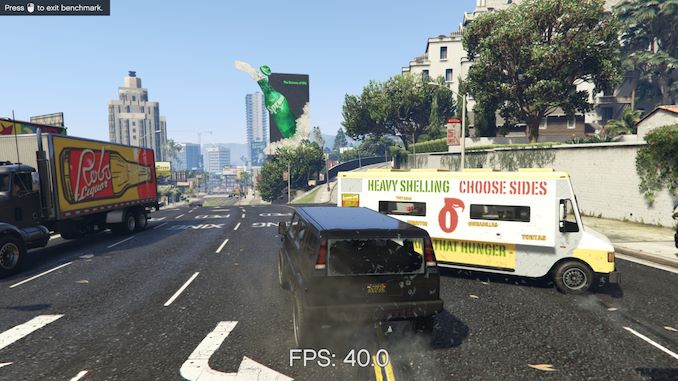
For testing, we wrote several scripts for the benchmark built into the game. The internal benchmark will include five scenarios: four short panoramic scenes with variable lighting and weather effects, plus a fifth - a sequence of actions lasting about 90 seconds. We decided to use only the last scene, which includes a jet flight, then a car ride through the city through several intersections, and at the end - a collision with a gasoline tank truck that explodes like the cars around it. This is a great combination of long-distance rendering, followed by short-range rendering. And fortunately, the game gives all the necessary test results.
There are no graphical presets in GTA, but the user can manually adjust parameters such as population density and drawing distance using the sliders. Other parameters such as texture / shadow / shaders / water quality switch from low quality to very high. Other settings include MSAA, soft shadows, post effects, shadow resolution, and advanced remote rendering settings. At the top of the screen there is a convenient option that shows how much video memory the game will consume with these parameters, with obvious consequences if the user requests more video memory than he has on the card (although there is no obvious hint if you have a weak GPU with more video memory, for example, R7 240 4 GB).

Igp

Low

Medium

High

Igp

Low

Medium

High

We see performance parity between chips at 4K resolution, but for all other resolutions and settings, the overclocked chip cannot reach the level of 7700K, often being in the middle between the default 7700K and 2600K.
The last game in the Ubisoft Far Cry series directs us directly to the unkind hands of the militarist cult in Montana, to one of the many provincial places in the United States. With a charismatic and mysterious opponent, gorgeous landscapes of northwest America and lots of violence, this is classic Far Cry. Graphically loaded game in the open world, where fighting and research are mixed.
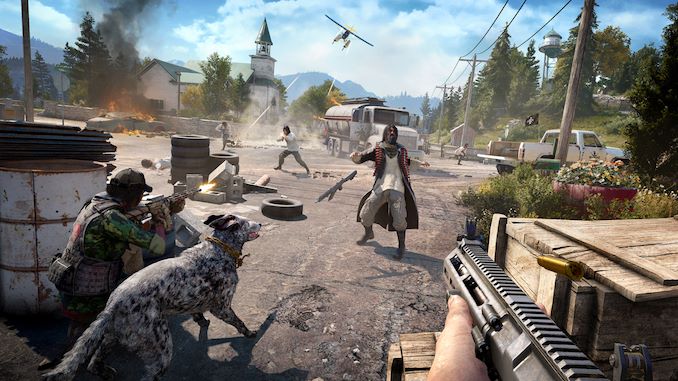
Far Cry 5 supports Vega-oriented features with Rapid Packed Math and Shader Intrinsics. Far Cry 5 also supports HDR (HDR10, scRGB and FreeSync 2). We use the built-in benchmark to get data and report the average and minimum frame rates.

Igp

Low

High

Igp

Low

High

As in some other games, there is equality with 4K, but below this resolution there is a big gap between 2600K and 7700K that overclocking cannot completely fix.
The latest representative of the Tomb Raider franchise avoids the sun, and prefers to hide in the shadows with the Shadow of the Tomb Raider. As expected, this action-adventure is again about Lara Croft, who is the main character of the franchise. Now she is making her way through the Mesoamerican and South American regions, trying to stop the Mayan apocalypse, which she herself unleashed. Shadow of the Tomb Raider is a direct continuation of the previous Rise of the Tomb Raider, was developed by Eidos Montreal and Crystal Dynamics and was published by Square Enix. The game hit the shelves in September 2018, and was released immediately for several platforms. This game actually closes the story of Lara Croft Origins, and received critical reviews after the release.

The integrated Shadow of the Tomb Raider benchmark is similar to the previous Rise of the Tomb Raider game, which we often used in the previous test suite. New Shadow of the Tomb Raider uses DirectX 11 and 12, and this particular game is advertised as one of the best implementations of DirectX 12 ever released.

Igp

Low

Medium

High

Igp

Low

Medium

High

Unfortunately, our overclocked system had problems with the SoTR test, but our results show that, starting with 1440P, the results of different chips will be more or less the same.
In addition to keeping the Formula 1 racing world up to date, F1 2017 added support for HDR, which F1 2018 also has. Otherwise, we would see how new versions of the Codemasters' EGO engine pave the way for F1. By claiming our rights to good graphics, F1 2018 provides a useful graphical load in our tests.

We use the built-in gaming test, which runs on the track in Montreal on a wet road, starting as Lewis Hamilton from the last place on the grid. Data is accepted for one lap race.

Igp

Low

Medium

High

Igp

Low

Medium

High

F1 2018 shows that the overclocked 2600K and 7700K are generally equal at 1080p and higher.
One of the risk factors for overclocking a processor is going beyond the ideal point of power and performance. Processors, as a rule, are made with special attention: maximum processor efficiency will be at a certain combination of voltage and frequency, and any deviation from this mark will lead to additional energy costs (usually to increase performance).
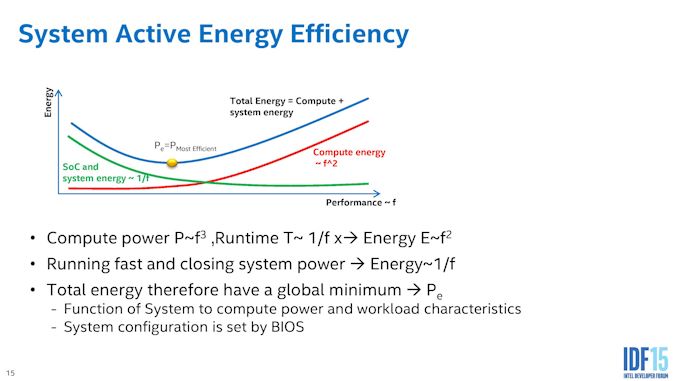
When Intel first introduced the Skylake family, this “point of maximum efficiency” became a key element in the product portfolio. Some processors will test and determine for them the point of maximum efficiency so that when idle the system consumes as little energy as possible. However, when the CPU actually executes the code, the system increases the frequency and voltage to ensure performance beyond this point of maximum efficiency. If the user raises this frequency much higher, it will be necessary to increase the voltage, and thus increase the power consumption.
Thus, when overclocking the processor, whether it is new or even relatively outdated, the user ultimately spends more energy on the same workload in order to make the workload faster. For our energy testing, we capture peak power consumption while using the maximum number of threads for our POV-Ray, using internal CPU metrics to record the total power of the SoC.
The Core i7-2600K was built on a 32nm Intel processor, while the i7-7700K and i7-9700K were built on Intel 14nm variants. The last two, as seen in the tests in this review, have significant performance advantages due to the microarchitecture, platform and frequency improvements that a more efficient process node offers. They also have AVX2, which consumes a lot of energy.

On the graph of peak power results, we see that the stock Core i7-2600K (3.5 GHz for all cores) has a power of only 88 watts, and the stock Core i7-7700K (4.3 GHz for all cores) is 95 watts. Both results look acceptable, but adding acceleration to 2600K to 4.7 GHz on all cores shows how much additional energy will be spent. At 116 W, overclocking by 34% consumes 31% more energy (which leads to an increase in performance by 24%) as compared to 2600K at “native” frequencies.
Core i7-9700K, with eight full cores, goes beyond the stated TDP, consuming 124 watts in stock form. Although Intel’s power consumption policy has not changed between generations, its interpretation, as we explained earlier in an article, has changed a lot.
As a direct quad-core processor from Intel, we give an analysis of all the results for the 2600K, overclocked 2600K, and the latest quad-core Intel processor with HyperThreading for desktop PCs, 7700K.
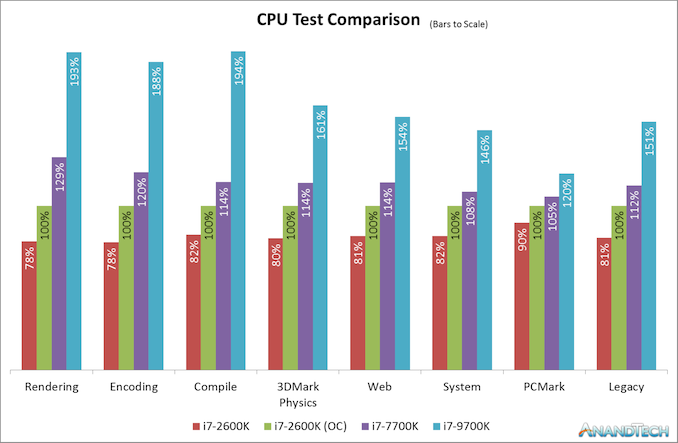
In our CPU tests, a veteran Core i7-2600K overclocked to 4.7 GHz on all cores (and with DDR3-2400 memory) shows an increase in performance by 10-24% compared to the standard settings and with the memory with the maximum frequency supported by Intel . This is exactly what the 2600K users liked - significant results were achieved, and the new processors, Intel, replacing the 2600K, did not provide the same level of performance gain.
However, compared to the Core i7-7700K, the latest quad-core Intel processor with HyperThreading, users were able to get another 8-29% of the performance from above. Using a processor for a variety of tasks is easy to see that getting the latest quad-core processor is justified for the user. It allows you to feel the benefits of more modern workloads, such as rendering or coding, especially given the fact that the gaming market has developed the mass culture of streaming. For more traditional workflows, such as PCMark or our outdated tests, there is an increase of only 5-12%. We also saw that some of our newer tests are already quite relevant.
As for the Core i7-9700K, which has eight full cores and now takes the place of the best Intel Core i7 processor, the performance gain here is much more noticeable, and in many cases almost twice as high as the overclocked Core i7-2600K (and more than double comparison with not overclocked).
The result of the “processor case” is obvious: the latest Intel quad-core with hyperthreading is an obvious improvement for the 2600K user, even without the need for overclocking. And the 9700K, which is in the same price category, is definitely easy to sell. True, from the point of view of computer games, the equation looks somewhat more complicated.
Modern games today work with higher resolutions and quality settings than during the launch of the Core i7-2600K. And also with new physical functions, new APIs and new game engines that can use the latest advances in CPU instructions, as well as modern communication between the processor and the graphics processor. We tested games with four quality settings for each game (720p, 1080p, 1440p-4K and 4K +). We used only the GTX 1080 video card, which is one of the high-end gaming cards of the last generation, and one of the most common among Core i7 users for high-end games.

When the Core i7-2600K was launched, 1080p games were in fashion. I don’t think I purchased a monitor with a resolution higher than 1080p before 2012, and before that I was playing with the clan programmers on screens that could be just 1366x768. The fact is that in modern games on an outdated resolution, such as 1080p, we see a significant gain from overclocking 2600K. Increasing the frame rate by 22% from 34% overclocking looks more than reasonable for any high-profile gamer.Over the next few years, Intel managed to improve FPS by only 12% - if we talk about the Core i7-7700K, relying mainly on increasing the frequency. Only on 9700K with a large number of cores, and when launching games that actually know what to do with the cores, we see another jump in performance.
, 1440p. 2600K 9700K FPS 9% . 4K, . , , API, - GPU, Core i7-2600K . , , .
, , . , .
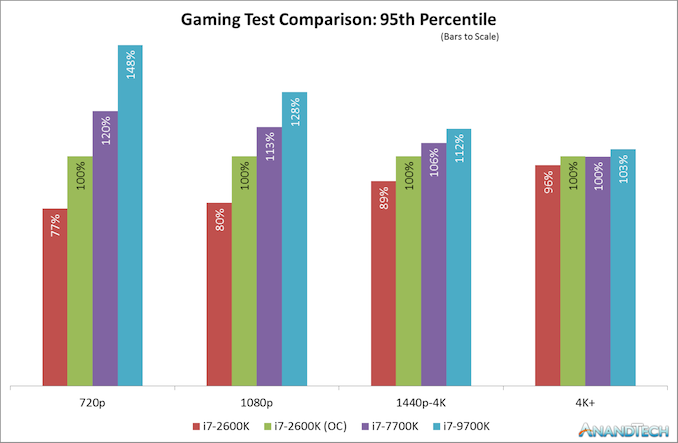
Core i7-2600K Core i7-9700K, , FPS. , Ashes of Singularity, 2600K 15% 4K, 9700K 6% , 2600K. , , .
2010-2011 . , CineBench R10, SuperPI, , . 2019 : , , , — . : , , . , .
, , : . , , , . (, SoC , , , .)
, . , 2011 Core i7-2600K, , . 2019 , . , / / , , .
. Sandy Bridge Core i7-2600K, 2011 , : , , , . , , : 20-40% CPU , Intel 3-8%, .
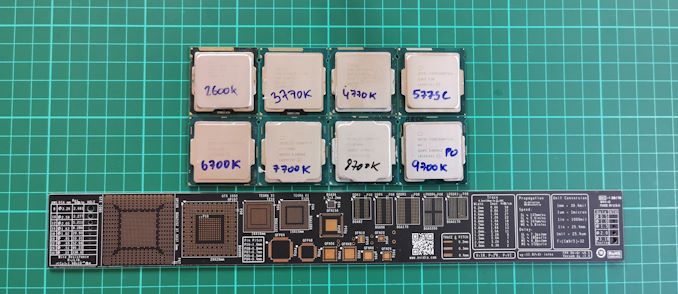
Core i7
Core i7-2600K . Intel Core i7, : Core i7-3770K, i7-4770K, i7-5775C, 6700K 7700K, (HT) 8700K ( HT) 9700K. , , , , .
, , , , . PCIe 3.0 , DDR4 , NVMe — , 2600K.
Core i7-2600K Intel (, ), Core i7-2600K, 3,5 4,7 , . Core i7-7700K, Intel Core i7 , , Intel HT, Core i7-9700K, Core i7.
, . — 2600K 7700K 2600K. , 20% , 7700K 20%. , , , AVX2. 7700K , . , Core i7-9700K .
, Core i7-2600K , , .
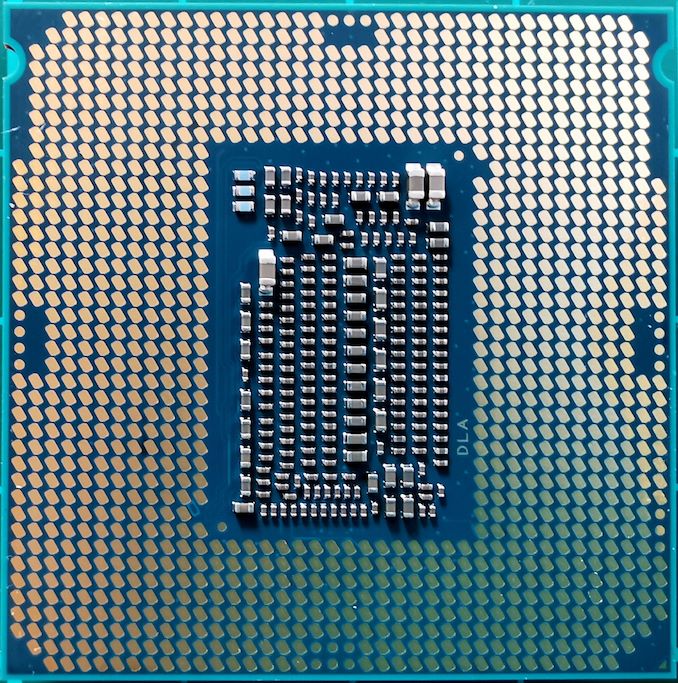
GPU . 2011 2019 - 1080p : , . . , API.
4K , i7-2600K , Core i7-9700K. 2600K , , . — Core i7-2600K - 60 FPS.
For users who prefer 1080p (or 1440p), but demanding a high frame rate to match the higher refresh rate of the display, there is a more tangible advantage to upgrade. New games on modern APIs can use more streams, which means a greater number of frame rendering calls (and more frames). This advantage can be realized with the help of the latest equipment Core i7. Core i7-7700K gives a good boost that can be improved using all eight core i7-9700K. Both of these chips can also be overclocked, although we have not considered this option.
In 2011 and 2012, I was a competitive overclocker, and my results were centered around using the Core i7-2600K as the basis for bringing my CPU and graphics processors to the limits. Daily performance gains for any of my tests on a CPU or GPU were noticeable, not only for work, but also for games in 1080p format.
Having moved again to the year 2019, there is only one or two reasons to stick with this old system, even if it is overclocked. The obvious reason is the price: if you cannot afford to upgrade, then this is quite a normal reason not to do it, and I hope that the old chip will work for you, as before. The second reason why you should not update is that the only thing you do as a gamer fan with a modern video card is 4K games.
There are a million other reasons to upgrade, even to the Core i7-7700K: all tasks tied to the processor, memory support (capacity and speed), storage support, new chipsets, new connection standards, AVX2, PCIe 3.0, multitasking, games and streaming, NVMe. Or, if this is important to you, RGB LED is a fashionable element of modern components.
At one time, we installed games from DVDs and used cold cathodes for RGB.

Picture from 2006 (?) Of the year - Battlefield 2 on CRT display. Launched on ATI X1900XTX and AMD Athlon 3400+
Thank you for staying with us. Do you like our articles? Want to see more interesting materials? Support us by placing an order or recommending to friends, 30% discount for Habr's users on a unique analogue of the entry-level servers that we invented for you: The Truth About VPS (KVM) E5-2650 v4 (6 Cores) 10GB DDR4 240GB SSD 1Gbps $ 20 or how to share the server? (Options are available with RAID1 and RAID10, up to 24 cores and up to 40GB DDR4).
Dell R730xd 2 times cheaper? Only we have 2 x Intel TetraDeca-Core Xeon 2x E5-2697v3 2.6GHz 14C 64GB DDR4 4x960GB SSD 1Gbps 100 TV from $ 199 in the Netherlands! Dell R420 - 2x E5-2430 2.2Ghz 6C 128GB DDR3 2x960GB SSD 1Gbps 100TB - from $ 99! Read about How to build an infrastructure building. class c using servers Dell R730xd E5-2650 v4 worth 9000 euros for a penny?

Game tests: World of Tanks enCore
Despite the fact that World of Tanks is very different from most other frequently played massively multiplayer online games, it allows the player to find himself in the middle of the 20th century and control a number of armored combat vehicles. World of Tanks (WoT) is developed and published by Wargaming, which are based in Belarus, and the soundtrack for the game is mainly written by the Belarusian composer Sergei Khmelevsky. The game offers several entry points, including free-to-play, and also allows players to pay for additional features. One of the most interesting facts about this tank-based MMO is that it reached eSports status when it debuted at World Cyber Games back in 2012.

')
World of Tanks enCore is a demo application for a new and unreleased graphics engine created by the Wargaming development team. Over time, the new main engine will be implemented in the full game, updating the game visual effects in the most key elements, such as improved water, flora, shadows, lighting, as well as other objects. The World of Tanks enCore demo application not only reveals information about upcoming changes in the game engine, but also allows users to check the system performance to make sure that the home system processes the new engine normally.

Average FPS
Igp

Low

Medium

High

95th Percentile
Igp

Low

Medium

High

As in many CPU tests, the 2600K overclocked is in the middle between the 2600K and 7700K stock, at least to 1080p Ultra. The 4K Ultra Overclocked 2600K and 7700K, in fact, have the same performance, but the base 2600K certainly has the worst result of the 95th percentile.
Final fantasy XV
Upon arrival to the computer not so long ago, the graphics of Final Fantasy XV: Windows Edition was redone because it was transferred from the console, as a result of their successful partnership with NVIDIA, with almost no mention of the production and development of the original Final Fantasy XV.
In preparation for the launch, Square Enix decided to release a stand-alone benchmark, which they recently updated. The use of stand-alone benchmark Final Fantasy XV gives us a long-term and reliable point of reference. Although it should be noted that the intensive use of NVIDIA technology by the benchmark means that it has problems with “maximum” parameters - it renders elements off-screen. To get around this, we use a standard preset that does not have these problems.

Square Enix patched the benchmark with custom graphic settings, and made corrections to give a more accurate result in the profiling of game performance, and the graphic parameters in the game. For testing, we run a standard benchmark with FRAP overlay using a 6-minute test record.
Average FPS
Igp

Low

Medium

High

95th Percentile
Igp

Low

Medium

High

As for Final Fantasy, all the chips worked basically the same, starting with 4K and higher (for some reason, the overclocked system test failed at 8K), but at 1080p the overclocked chip is still between the 2600K / 7700K stock.
Civilization 6 (DX12)
Originally launched by Sid Meier and his team, the Civ series of turn-based strategies became a cult classic. Many apologies were made for the sleepless nights of the players, who could not make Gandhi go to war because of the overflow of whole numbers. In truth, I have never played the first version, but I played in every part from the second to the sixth, including the fourth, voiced by the late Leonard Nimy. This is a game that is easy to play, but hard to play well.

Civilization benchmarking has always been something like an oxymoron - for a turn-based strategy game the frame rate is not particularly important, and with the right mood, only 5 frames per second is enough for a good game. However, with Civilization 6, Firaxis has hit hardcore and raised the visualization bar, trying to get you involved in the game. As a result, Civilization may require from the player a new video card and processor, especially if you play with high details under DirectX 12.
Perhaps a more in-demand result will be visible during a late game, when, in older versions, Civilization could take 20 minutes to make the AI players move and transfer control to the person. The new version of Civilization has an integrated “AI Benchmark”, although at present it is not yet included in our portfolio of tests for technical reasons that we are trying to solve. Instead, we run a graphical test, which provides an example of average game settings in options.

Average FPS
Igp

Low

Medium

High

95th Percentile
Igp

Low

Medium

High

Civilization is a game that does not depend on the frame rate by itself, and the inclusion of all settings helps a lot. However, even in 4K, there is a noticeable difference in runoff performance of 2600K and 7700K, which is halved when 2600K is overclocked.
Ashes Classic (DX12)
The beloved child of DirectX12, Ashes of the Singularity (AoTS or simply Ashes) was the first name to actively explore as many DirectX12s features as possible. Stardock, the developer of the Nitrous engine that runs the game, made sure that the real-time strategy takes advantage of several cores and several video cards in the maximum possible set of configurations.

As real-time strategy is supposed to be, Ashes is a quick response both during wide open species and in mass battles. With DirectX12 at the helm, the ability to make more calls per second allows the engine to work with a significant depth of drawing units and effects. At the same time, some other RTSs had to rely on combined drawing, making the combined unit structures very rigid.
Stardock well understands the need for an internal benchmark test in the game, ensuring that this tool is available and operational from the day the game is released. This is especially important given the use of all the new features of the DX12, since it was important for the developer to understand how they affected the game. The in-game test performs a four-minute fixed battle scene with multiple shots and displays a huge amount of data for analysis.
For our test, we run Ashes Classic - an older version of the game, before updating Escalation. The old version is easier to automate, it does not use splash screen, but still has good visual accuracy for testing.
Average FPS
Igp

Low

Medium

High

95th Percentile
Igp

Low

Medium

High

Ashes has a drop-down menu with settings for MSAA, Light Quality, Object Quality, Shading Samples, Shadow Quality, textures and individual settings for the landscape. There are several presets, from Very Low to Extreme. We run our tests on various settings and derive the average FPS and 95th percentile.
In Ashes, we see a difference in performance between chips up to 4K, but the overclocked 2600K and the stock 7700K work almost equally on 4K. Starting at 1440p and lower, the overclocked 2600K begins to lag far behind the 7700K, showing the difference between the two architectures and platforms.
Strange Brigade (DX12, Vulkan)
Strange Brigade takes the player to Egypt in 1903 and follows a story that is very similar to the story of the Mummy movie series. This typical third-person shooter was developed by Rebellion Developments, which is more widely known for its Sniper Elite and Alien vs Predator games. The game follows the idea of hunting for the Tzetkas - the Witch Queen, who has resurrected again, as part of a single "squad" that can eventually stop her. The gameplay is focused on the cooperative passage, with a wide arsenal of different levels and a lot of puzzles that will be solved by a group of British agents of the colonial secret service, whose goal is to put an end to the reign of barbarism and cruelty.

The game supports both the DirectX 12 API and the Vulkan API and includes its own built-in test, which offers various settings, including textures, anti-aliasing, reflections, rendering distance, and even allows users to enable or disable image blur, ambient occlusion, tessellation, etc. . Earlier, AMD boasted that Strange Brigade uses its own Vulkan API integration, which implies scalability when using several AMD graphics cards on a player's machine.

Average FPS
Igp

Low

Medium

High

95th Percentile
Igp

Low

Medium

High

In Strange Brigade, all chips (except for the stock 2600K) work the same way at 1080p and higher. Which means that there is no reason to upgrade if this is the only game you play.
Grand theft auto v
The long-awaited iteration of the Grand Theft Auto franchise hit the shelves on April 14, 2015, and AMD and NVIDIA made efforts to optimize the game. There are no graphic presets in GTA, but still the game opens up new possibilities for users and expands the boundaries of modern graphics, loading even the most powerful computers to the limit with the aid of the Rockstar Advanced Game Engine under DirectX 11. Regardless of whether the user flies high in the mountains, where you need to draw the world at long distances, or deal with sorted garbage in the city, when it is bent to the maximum, the game creates stunning visual effects, plus hard work for both the processor and the graphics card.

For testing, we wrote several scripts for the benchmark built into the game. The internal benchmark will include five scenarios: four short panoramic scenes with variable lighting and weather effects, plus a fifth - a sequence of actions lasting about 90 seconds. We decided to use only the last scene, which includes a jet flight, then a car ride through the city through several intersections, and at the end - a collision with a gasoline tank truck that explodes like the cars around it. This is a great combination of long-distance rendering, followed by short-range rendering. And fortunately, the game gives all the necessary test results.
There are no graphical presets in GTA, but the user can manually adjust parameters such as population density and drawing distance using the sliders. Other parameters such as texture / shadow / shaders / water quality switch from low quality to very high. Other settings include MSAA, soft shadows, post effects, shadow resolution, and advanced remote rendering settings. At the top of the screen there is a convenient option that shows how much video memory the game will consume with these parameters, with obvious consequences if the user requests more video memory than he has on the card (although there is no obvious hint if you have a weak GPU with more video memory, for example, R7 240 4 GB).

Average FPS
Igp

Low

Medium

High

95th Percentile
Igp

Low

Medium

High

We see performance parity between chips at 4K resolution, but for all other resolutions and settings, the overclocked chip cannot reach the level of 7700K, often being in the middle between the default 7700K and 2600K.
Far cry 5
The last game in the Ubisoft Far Cry series directs us directly to the unkind hands of the militarist cult in Montana, to one of the many provincial places in the United States. With a charismatic and mysterious opponent, gorgeous landscapes of northwest America and lots of violence, this is classic Far Cry. Graphically loaded game in the open world, where fighting and research are mixed.

Far Cry 5 supports Vega-oriented features with Rapid Packed Math and Shader Intrinsics. Far Cry 5 also supports HDR (HDR10, scRGB and FreeSync 2). We use the built-in benchmark to get data and report the average and minimum frame rates.

Average FPS
Igp

Low

High

95th Percentile
Igp

Low

High

As in some other games, there is equality with 4K, but below this resolution there is a big gap between 2600K and 7700K that overclocking cannot completely fix.
Shadow of the Tomb Raider (DX12)
The latest representative of the Tomb Raider franchise avoids the sun, and prefers to hide in the shadows with the Shadow of the Tomb Raider. As expected, this action-adventure is again about Lara Croft, who is the main character of the franchise. Now she is making her way through the Mesoamerican and South American regions, trying to stop the Mayan apocalypse, which she herself unleashed. Shadow of the Tomb Raider is a direct continuation of the previous Rise of the Tomb Raider, was developed by Eidos Montreal and Crystal Dynamics and was published by Square Enix. The game hit the shelves in September 2018, and was released immediately for several platforms. This game actually closes the story of Lara Croft Origins, and received critical reviews after the release.

The integrated Shadow of the Tomb Raider benchmark is similar to the previous Rise of the Tomb Raider game, which we often used in the previous test suite. New Shadow of the Tomb Raider uses DirectX 11 and 12, and this particular game is advertised as one of the best implementations of DirectX 12 ever released.

Average FPS
Igp

Low

Medium

High

95th Percentile
Igp

Low

Medium

High

Unfortunately, our overclocked system had problems with the SoTR test, but our results show that, starting with 1440P, the results of different chips will be more or less the same.
F1 2018
In addition to keeping the Formula 1 racing world up to date, F1 2017 added support for HDR, which F1 2018 also has. Otherwise, we would see how new versions of the Codemasters' EGO engine pave the way for F1. By claiming our rights to good graphics, F1 2018 provides a useful graphical load in our tests.

We use the built-in gaming test, which runs on the track in Montreal on a wet road, starting as Lewis Hamilton from the last place on the grid. Data is accepted for one lap race.

Average FPS
Igp

Low

Medium

High

95th Percentile
Igp

Low

Medium

High

F1 2018 shows that the overclocked 2600K and 7700K are generally equal at 1080p and higher.
Power consumption
One of the risk factors for overclocking a processor is going beyond the ideal point of power and performance. Processors, as a rule, are made with special attention: maximum processor efficiency will be at a certain combination of voltage and frequency, and any deviation from this mark will lead to additional energy costs (usually to increase performance).

When Intel first introduced the Skylake family, this “point of maximum efficiency” became a key element in the product portfolio. Some processors will test and determine for them the point of maximum efficiency so that when idle the system consumes as little energy as possible. However, when the CPU actually executes the code, the system increases the frequency and voltage to ensure performance beyond this point of maximum efficiency. If the user raises this frequency much higher, it will be necessary to increase the voltage, and thus increase the power consumption.
Thus, when overclocking the processor, whether it is new or even relatively outdated, the user ultimately spends more energy on the same workload in order to make the workload faster. For our energy testing, we capture peak power consumption while using the maximum number of threads for our POV-Ray, using internal CPU metrics to record the total power of the SoC.
The Core i7-2600K was built on a 32nm Intel processor, while the i7-7700K and i7-9700K were built on Intel 14nm variants. The last two, as seen in the tests in this review, have significant performance advantages due to the microarchitecture, platform and frequency improvements that a more efficient process node offers. They also have AVX2, which consumes a lot of energy.

On the graph of peak power results, we see that the stock Core i7-2600K (3.5 GHz for all cores) has a power of only 88 watts, and the stock Core i7-7700K (4.3 GHz for all cores) is 95 watts. Both results look acceptable, but adding acceleration to 2600K to 4.7 GHz on all cores shows how much additional energy will be spent. At 116 W, overclocking by 34% consumes 31% more energy (which leads to an increase in performance by 24%) as compared to 2600K at “native” frequencies.
Core i7-9700K, with eight full cores, goes beyond the stated TDP, consuming 124 watts in stock form. Although Intel’s power consumption policy has not changed between generations, its interpretation, as we explained earlier in an article, has changed a lot.
Quad-Core CPU Comparison: CPU Tests
As a direct quad-core processor from Intel, we give an analysis of all the results for the 2600K, overclocked 2600K, and the latest quad-core Intel processor with HyperThreading for desktop PCs, 7700K.

In our CPU tests, a veteran Core i7-2600K overclocked to 4.7 GHz on all cores (and with DDR3-2400 memory) shows an increase in performance by 10-24% compared to the standard settings and with the memory with the maximum frequency supported by Intel . This is exactly what the 2600K users liked - significant results were achieved, and the new processors, Intel, replacing the 2600K, did not provide the same level of performance gain.
However, compared to the Core i7-7700K, the latest quad-core Intel processor with HyperThreading, users were able to get another 8-29% of the performance from above. Using a processor for a variety of tasks is easy to see that getting the latest quad-core processor is justified for the user. It allows you to feel the benefits of more modern workloads, such as rendering or coding, especially given the fact that the gaming market has developed the mass culture of streaming. For more traditional workflows, such as PCMark or our outdated tests, there is an increase of only 5-12%. We also saw that some of our newer tests are already quite relevant.
As for the Core i7-9700K, which has eight full cores and now takes the place of the best Intel Core i7 processor, the performance gain here is much more noticeable, and in many cases almost twice as high as the overclocked Core i7-2600K (and more than double comparison with not overclocked).
The result of the “processor case” is obvious: the latest Intel quad-core with hyperthreading is an obvious improvement for the 2600K user, even without the need for overclocking. And the 9700K, which is in the same price category, is definitely easy to sell. True, from the point of view of computer games, the equation looks somewhat more complicated.
Quad-Core Comparison: GPU Tests
Modern games today work with higher resolutions and quality settings than during the launch of the Core i7-2600K. And also with new physical functions, new APIs and new game engines that can use the latest advances in CPU instructions, as well as modern communication between the processor and the graphics processor. We tested games with four quality settings for each game (720p, 1080p, 1440p-4K and 4K +). We used only the GTX 1080 video card, which is one of the high-end gaming cards of the last generation, and one of the most common among Core i7 users for high-end games.

When the Core i7-2600K was launched, 1080p games were in fashion. I don’t think I purchased a monitor with a resolution higher than 1080p before 2012, and before that I was playing with the clan programmers on screens that could be just 1366x768. The fact is that in modern games on an outdated resolution, such as 1080p, we see a significant gain from overclocking 2600K. Increasing the frame rate by 22% from 34% overclocking looks more than reasonable for any high-profile gamer.Over the next few years, Intel managed to improve FPS by only 12% - if we talk about the Core i7-7700K, relying mainly on increasing the frequency. Only on 9700K with a large number of cores, and when launching games that actually know what to do with the cores, we see another jump in performance.
, 1440p. 2600K 9700K FPS 9% . 4K, . , , API, - GPU, Core i7-2600K . , , .
, , . , .

Core i7-2600K Core i7-9700K, , FPS. , Ashes of Singularity, 2600K 15% 4K, 9700K 6% , 2600K. , , .
Intel Core i7-2600K:
2010-2011 . , CineBench R10, SuperPI, , . 2019 : , , , — . : , , . , .
, , : . , , , . (, SoC , , , .)
, . , 2011 Core i7-2600K, , . 2019 , . , / / , , .
. Sandy Bridge Core i7-2600K, 2011 , : , , , . , , : 20-40% CPU , Intel 3-8%, .

Core i7
Core i7-2600K . Intel Core i7, : Core i7-3770K, i7-4770K, i7-5775C, 6700K 7700K, (HT) 8700K ( HT) 9700K. , , , , .
, , , , . PCIe 3.0 , DDR4 , NVMe — , 2600K.
Core i7-2600K Intel (, ), Core i7-2600K, 3,5 4,7 , . Core i7-7700K, Intel Core i7 , , Intel HT, Core i7-9700K, Core i7.
, . — 2600K 7700K 2600K. , 20% , 7700K 20%. , , , AVX2. 7700K , . , Core i7-9700K .
, Core i7-2600K , , .

GPU . 2011 2019 - 1080p : , . . , API.
4K , i7-2600K , Core i7-9700K. 2600K , , . — Core i7-2600K - 60 FPS.
For users who prefer 1080p (or 1440p), but demanding a high frame rate to match the higher refresh rate of the display, there is a more tangible advantage to upgrade. New games on modern APIs can use more streams, which means a greater number of frame rendering calls (and more frames). This advantage can be realized with the help of the latest equipment Core i7. Core i7-7700K gives a good boost that can be improved using all eight core i7-9700K. Both of these chips can also be overclocked, although we have not considered this option.
The essence
In 2011 and 2012, I was a competitive overclocker, and my results were centered around using the Core i7-2600K as the basis for bringing my CPU and graphics processors to the limits. Daily performance gains for any of my tests on a CPU or GPU were noticeable, not only for work, but also for games in 1080p format.
Having moved again to the year 2019, there is only one or two reasons to stick with this old system, even if it is overclocked. The obvious reason is the price: if you cannot afford to upgrade, then this is quite a normal reason not to do it, and I hope that the old chip will work for you, as before. The second reason why you should not update is that the only thing you do as a gamer fan with a modern video card is 4K games.
There are a million other reasons to upgrade, even to the Core i7-7700K: all tasks tied to the processor, memory support (capacity and speed), storage support, new chipsets, new connection standards, AVX2, PCIe 3.0, multitasking, games and streaming, NVMe. Or, if this is important to you, RGB LED is a fashionable element of modern components.
At one time, we installed games from DVDs and used cold cathodes for RGB.

Picture from 2006 (?) Of the year - Battlefield 2 on CRT display. Launched on ATI X1900XTX and AMD Athlon 3400+
Thank you for staying with us. Do you like our articles? Want to see more interesting materials? Support us by placing an order or recommending to friends, 30% discount for Habr's users on a unique analogue of the entry-level servers that we invented for you: The Truth About VPS (KVM) E5-2650 v4 (6 Cores) 10GB DDR4 240GB SSD 1Gbps $ 20 or how to share the server? (Options are available with RAID1 and RAID10, up to 24 cores and up to 40GB DDR4).
Dell R730xd 2 times cheaper? Only we have 2 x Intel TetraDeca-Core Xeon 2x E5-2697v3 2.6GHz 14C 64GB DDR4 4x960GB SSD 1Gbps 100 TV from $ 199 in the Netherlands! Dell R420 - 2x E5-2430 2.2Ghz 6C 128GB DDR3 2x960GB SSD 1Gbps 100TB - from $ 99! Read about How to build an infrastructure building. class c using servers Dell R730xd E5-2650 v4 worth 9000 euros for a penny?
Source: https://habr.com/ru/post/455658/
All Articles